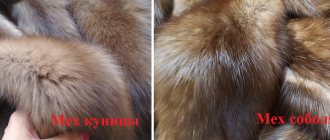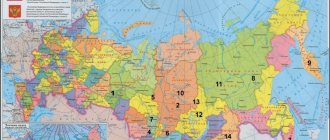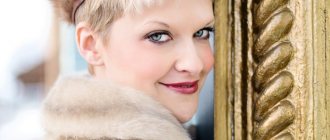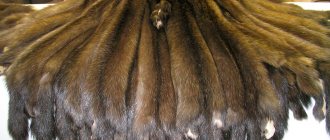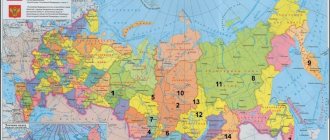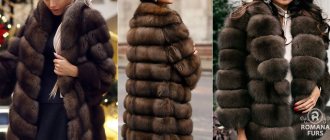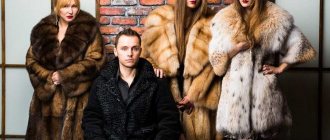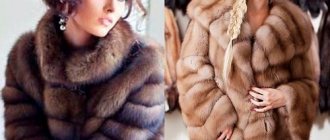As biologists say, the Russian sable (Martes zibellina), which belongs to the general large family of mustelids, lives in the wild. This entire family is valuable for the fur trade, although, in fairness, it is worth saying that the price of its individual representatives varies somewhat.
Its closest relative, which is similar to it both in appearance and way of life, is the American (Canadian) Martes americana. This is where the confusion begins, because biologists call this “relative” the marten, but fur craftsmen call it the Canadian sable. And all the international disputes that the Soyuzfur Association initiated, that the Canadian sable is essentially still a marten, did not lead to changes in the fur classification.
Canadian sable: differences from marten and Russian sable
The fact is that for manufacturers of fur coats and hats, the fur of the Canadian is much more different from the fur of the pine marten (Martes martes) than from the fur of its Russian brother: 1. The ridge of the Canadian is colored darker than the sides. The marten is always monochromatic; 2. The very structure of the main hair and the down of the Canadian and the pine marten differ in appearance.
So, in fact, a Canadian sable fur coat is made from marten, and in appearance it resembles the fur of Russian sable of the eastern ridges : lower and coarser hair, yellow (red) shade of color. There are even very light skins, whose color is called “canary”.
Canadian sable has virtually no price differences, unlike mink. The fact is that the quality of the skins of a given animal is often similar: they do not differ in splendor, density of underfur, or silkiness. And the color is limited to yellow shades; they do not come in blue or silver.
“I am a person, not a fur coat!” — An honest interview about domestic sables
For several years now, future educational psychologist Evgenia Fedorchenko has been running the Russian sable page on Instagram. During this time, the number of subscribers who want to watch the life of a Russian sable named Umora has exceeded 180 thousand. But what is the history of acquiring such an unusual pet?
In an interview with the owner of the sable Umora, 5-tv.ru found out how to keep a wild animal at home, how much it costs and what is really going on on fur farms.
About the decision to get a sable
“Ever since I was a child, I have tried to help animals. I fed the homeless, rescued the wounded, and I always had pets. One day I was looking for advertisements to buy a dog and accidentally came across the sale of sables. I didn’t know that you could keep them at home and, in principle, I wasn’t interested in them at all. I didn’t even know exactly what they looked like. I saw this cute little face and started researching the issue.
They write complete nonsense on the Internet about this being a pet! That it is very sweet, kind and well-adjusted. This later turned out to be untrue. After several years of thinking about whether to buy sable, I finally decided that I should take it. Moreover, I learned that they can be bought from fur farms, thereby saving them from slaughter.”
Instagram @russian_sable
About fur farms
“Fur farms are places where furs are raised for slaughter for fur. There are a lot of species there: mink, sable, foxes, raccoons. They raise them and then at special auctions, the animals are bought by fur houses and studios. But they also sell live young animals. In principle, they don’t care who or in what form they sell it to. Sables cost from 15 thousand rubles.
Before going there, I called an employee of the Saltykovskaya fur farm in Balashikha and agreed on a time. The living conditions there are simply disgusting! Terrible smell, small cells. Of course, it is not very pleasant to see active and adult animals sitting in cages without the ability to move. While sables and minks at least have houses where they can hide, foxes simply sit in lattice cages without a bottom. Young animals are slaughtered six months after birth.”
Evgenia Fedorchenko and the sable Umora. Instagram @russian_sable
About the period of adaptation and getting used to each other
“It took us a long time to get used to each other. When I came to pick up the sable, I wanted to take a month old and they assured me that she was one month and two days old. But when I checked the photos and talked to other people who also bought sables, it turned out that Umore is actually two or two and a half months old. Taming became much more difficult.
I don’t know what happened to her at the fur farm, but when I took her, her nose was torn. From the first day she was very angry and hysterical. She was aggressive, cursing and biting. Therefore, establishing contact took more than six months. She is almost two years old and only now is it becoming normal to live with her.
I can say that when they took her out of the cage, she immediately squealed and screamed. I bit the livestock technician’s gloves, I immediately recoiled and thought: why am I even getting involved in this? I didn’t expect that such a small puppy, who fits in the palm of my hand, could behave like this. But when I was offered to choose someone else, I realized that she would now be returned there and that’s all... I would deprive her of her chance to live, and she would be killed. Sables are very rarely bought.
This animal is not domesticated and is wild. Of course, animals from a fur farm will not survive in the wild, but their instincts are stronger than those of cats or dogs. Before you take it, you need to study a lot of literature and understand that much in the apartment will have to be adjusted to suit the sable. An animal requires a lot of time. If you don’t interact with her, she will start to run wild and very quickly lose the habit of being handled.”
The fun is about two and a half months. Instagram @russian_sable
About how much it costs to keep a sable
“Four to five thousand rubles a month are spent on food and toys. I feed her premium dry dog food. I make sure to give him blueberries, pine nuts, fruits and vegetables every day.
In Moscow there are no problems with medical care for such animals. There are specialists in exotics, but in two years the help of a veterinarian has never been required. The only time I took her for vaccinations, she started to get hysterical and the trip was unsuccessful. Since then, I have been giving her vaccinations myself. But, despite her wayward character, I calmly taught her to trim her nails, comb her teeth, and brush her teeth. She goes to the toilet in the litter box, although it took her a long time to get used to this and actively marked everything. Now sometimes.
I tried to walk Uma, but it was all accompanied by hysterics. She screams so hard her tongue turns blue. This happens with fur farms because they are afraid of large open spaces because they sit in cages.”
Instagram @russian_sable
About the benefits of the Umora page
“I remember there was an incident! One girl blogger was looking for a fur coat and accidentally came across Umora using hashtags. She liked one publication so much that she posted it on her website and wrote that after looking at the photos, she no longer dreams of a fur coat. And after that, many users and media noticed Umoru. They started talking about her.”
Evgeniya hopes that such attention, coupled with Umora’s sable account on the social network, will influence people. Maybe someone would prefer to give life to a cute forest animal instead of purchasing a jacket or coat. Maybe keeping animals on fur farms will make it just a little more bearable. And someone will seriously think about it and weigh everything before taking home a rather exotic and difficult pet.
What types of sable are the most expensive?
So, if we return to the mustelid family, then the leader in cost will undoubtedly be the Barguzin sable. And the quality of the fur, unless, of course, it was spoiled by inept processing, is beyond praise. The color is rich brown, with many gray (silver) hairs that give it shine and shine. It is followed by the Yenisei sable. It can be colored in all possible shades from “caramel” to natural flesh and silvery hairs are much less visible. But in third place is the Canadian sable. It has the lowest price in the “sable” range, but pine marten is valued even cheaper.
The mustelid family, especially the sable, is not very favored in animal farms. Unlike minks, where selection allows for the development of fur of amazing colors, unique in properties and appearance, sable in particular and mustelids generally lose in price and quality when kept in captivity.
How to distinguish sable fur from marten fur?
When producing fur coats, the color of the marten can be natural. Today we use two main colors in tailoring: cake and brown.
Here are the main differences between mustel and sable fur:
— Sable is characterized by silkiness, softness, and unique shine, while marten is a coarser material that has a dense down and does not have the same shine as sable skins;
— If we talk about undercoat, sable also has it, but it is soft and has a bluish tint;
— As a rule, marten fur is brown in color, and before making products from it, the material is dyed. Sable has a pleasant honey shade, which can be dark and rich, but it only benefits from this;
— The cost of sable is an order of magnitude higher than the price of marten. You can verify this by studying the catalog of the online store fursk.ru.
We present models made from both types of skins; the prices of the products are appropriate, but the appearance and quality of the items are consistently high.
For comparison: in our catalog, the cost of a marten fur coat ranges from 140-150 thousand rubles, while a jacket or short fur coat made of sable skins will cost from about 400 thousand rubles.
Disadvantages of the Canadian Sable
As for the products themselves, there is one more point: the fur of the Canadian sable can seem to “disintegrate” or, as experts say, “prick” at the seams, forming a clear transition from skin to skin. Therefore, when sewing a sable fur coat, the fur is often combined with leather or lace inserts, and the style is chosen with a wide armhole - this way the looseness fits more beautifully.
So, if you see two similar coats, but one says “marten” and the other says “Canadian sable,” don’t be surprised. It’s just that the manufacturer is more inclined to Russian or American fur labeling. But in fact, it could be the same fur. Although keep in mind that “marten” can also be labeled as the already mentioned “pine marten,” which is somewhat cheaper.
Symbol of Siberia. Coins with the image of a sable
In Volume 16 of the Complete Collection of Laws of the Russian Empire, you can read the Nominal Decree 11983 “On the circulation of a new copper coin made in Siberia at the Kolyvano-Voskresensk factories, in all government and private fees and payments in the Siberian province alone.” The paper was signed on December 5, 1763 by Empress Catherine II.
Example page of the Complete Collection of Laws of the Russian Empire, volume 16, 1762.
From that moment on, territorial money came into use in Russia exclusively for circulation in the Siberian kingdom from Tara to Kamchatka. The trial coins had the coat of arms of the Siberian Kingdom on the reverse, but for regular circulation they began to mint sables (reverse) and the monogram of the empress (obverse). The denomination of the coin and the year of its issue were also placed on the reverse. There were six denominations in regular circulation: 10, 5, 2 and 1 kopeck, as well as money and half a kopeck. Instead of the Siberian coat of arms, the polushka contained only a shield with a denomination. The issue ended in 1781. You can read a lot of facts and speculations about the existing versions of the reasons for the creation of such money, but something else is important - the design of the coins was developed in St. Petersburg, and they became an important milestone in the economic development of the territory discovered by Ermak and which had difficulty getting used to its new owners. Under Catherine’s monogram was the abbreviation KM - Kolyvan Copper. Minting was carried out by the Suzun Mint. Over the years of its existence, the Siberian coin has undergone many changes, and currently many fakes and copies are sold on the market.
Siberian coin 10 kopecks with sable, KM, 1777
Sable is a special topic in Russian heraldry and relates primarily to the Siberian theme of the 17th century. At this time, Siberia was strongly associated with sable, whose fur was of great commercial importance. This animal in various forms is depicted on the coats of arms of the Sverdlovsk, Tyumen and Novosibirsk regions, Yakutsk, Irkutsk, Megion, Yeniseisk, Pervouralsk, uluses of Yakutia, districts of the Yamalo-Nenets Autonomous Okrug, Khanty-Mansi Autonomous Okrug and the Krasnoyarsk Territory. In total, sable is present on more than 30 coats of arms of the constituent entities of the Federation, cities and regions of Russia; Numismatists will be interested in the fact that some of them were issued on modern ten-ruble coins from the “Russian Federation” series.
The first “sable” coin in the series appeared in 2007. The Novosibirsk region and Novosibirsk have similar coats of arms with two black sables holding a golden loaf with a salt shaker in their paws.
Coin 10 rubles Sable “Novosibirsk region”, 2007
Novosibirsk is the largest city in Siberia, it is also the third largest city in Russia. Population more than 1.6 million people. It was founded in 1893 and received city status 10 years later. Here is the largest theater in Russia, and the Glavny railway station looks like a huge steam locomotive and was put into operation 80 years ago, in 1939. More than half a century ago, Akademgorodok appeared - the center of the Siberian branch of the Russian Academy of Sciences, included in the list in 2014 objects of cultural heritage.
Technopark of Novosibirsk Akademgorodok
The coat of arms of the Tyumen region also could not do without black and gold sables. The 2014 10 ruble coin issued by the St. Petersburg Mint is dedicated to the region. On the obverse is the coat of arms of the region: animals stand on their hind legs on golden arrows, and hold a shield with their front legs. At the bottom there is the inscription “Siberia will grow” - an echo of Lomonosov’s famous phrase. And it is no coincidence, because in terms of area the region, together with the autonomous okrugs, ranks 3rd among all subjects of the Russian Federation, second only to Yakutia and the Krasnoyarsk Territory.
Coin 10 rubles Sable “Tyumen Region”, 2014
The oil and gas capital of Russia, Tyumen, is among the leaders in the ranking of the quality of life of Russian cities, and the black sables on the regional coat of arms have acquired a second, unofficial, but quite modern meaning due to the color of the oil. However, on the coat of arms of Tyumen, sables were replaced by beaver and fox shield holders as the personification of labor and intelligence, also black.
But the proud sable is also a victim. On the coat of arms of the Irkutsk region and its capital, a babr holds a scarlet (red) sable in its mouth. An unfortunate mistake led to the appearance of an unknown animal. “Babr” in the local dialect means “tiger,” and it was this predator that had been holding sable in its teeth since 1690. And in 1859, officials confused it with a beaver. As a result, a fictional beast walks on the shield: bloodthirsty, with webbed paws, a thick tail and a cat's muzzle. This is how he appears on the 10 ruble coin “Irkutsk Region” of the “Russian Federation” series, issued in 2021. And the Barguzin or Angara sable is his prey.
Coin 10 rubles Sable “Irkutsk region”, 2021
In 2008, the Mints of Moscow and St. Petersburg with a circulation of 10 million copies. mint a 10 ruble coin “Sverdlovsk Region”. And again the sable, but now it is located on the shield in the center and with an arrow. The sable serves as an indication of the initial development of the region as part of the Siberian kingdom. Sable is not the traditional black, but silver. This is an indication not of fur value, but of closeness with another animal of the mustelid kingdom - the ermine as a symbol of purity. The shield is held by two griffins guarding the Ural ridge.
Coin 10 rubles Sable “Sverdlovsk Region”, 2008
The capital of the Sverdlovsk region, Yekaterinburg, was renamed in Soviet times in honor of the revolutionary Yakov Sverdlov, who came to the center of the Urals in 1905 to organize party work. The city was founded in 1723 at the beginning of the work of the State Metallurgical Plant and named in honor of Empress Catherine I. It received city status in 1781. Currently, it is the fourth largest populated area in Russia, where almost 1.5 million people live. On the coat of arms of Yekaterinburg, a sable holds a shield together with a bear. After the renaming of Sverdlovsk to Yekaterinburg in 1991, the region was not renamed. Among the nine wonders of the region are the megaliths - the Seven Brothers and One Sister rocks. The most picturesque in the Middle Urals, popular among climbers and included in the habitat of the Tobolsk sable.
Rocks Seven Brothers and One Sister
The Republic of Bashkortostan is simultaneously part of the Volga and Ural economic regions. It borders the Sverdlovsk region and is also heraldically associated with the sable. On the silver coin of 3 rubles “Monument of Friendship of Ufa” in the series “Architectural Monuments of Russia” 900 samples with a circulation of 3 thousand copies. On the right side of the shield of the city's coat of arms is a marten. The fur of marten and sable was especially famous in ancient times in those places, but there were fewer sables, so marten fur was often counterfeited as more expensive sable, and “craftsmen” still do this now.
3 ruble coin “Architectural monuments of Russia. Ufa", 1999
The sable became the central character of seven coins in the “Save Our World” series, dedicated to the unique animal world of Russia. These include rare and endangered species included in the Red Book. Sable is called the king of wild furs, and its fur is “soft gold.” As if to confirm this, five coins with sables were issued in 1994, four of them in 999-carat gold.
Gold coin 100 rubles “Sable”, 1994, circulation 2500 copies.
One of the silver coins with sables is 100 rubles 1996 with the image of a sable couple against the backdrop of an ancient Russian city. Its circulation is only 500 copies.
Silver coin 100 rubles “Sable”, 1996
And the largest circulation of a silver coin with the image of a sable is 1 million copies. In 1995, 3 rubles from the Leningrad and Moscow mints saw the light of day. This is a classic 925 silver bullion coin. Since 2001, by decision of the Central Bank, it has been used as a legal means of payment.
Coin 3 rubles 1995 with a sable sitting on a branch
The sable, as the personification of beauty, independence, grace and speed, was chosen as the mascot of the Winter Spartakiads of the peoples of the USSR in Krasnoyarsk in 1982 and 1986. Later, a sable with a torch became a symbol of the Winter Spartakiad of the Peoples of Siberia, held in Krasnoyarsk in 2005. No special coins dedicated to these sports holidays were produced, however, the number and variety of medals and badges is impressive.
Table medal “Participant of the V Winter Spartakiad of the Peoples of the USSR. Krasnoyarsk 1982"
Krasnoyarsk, another Siberian “millionaire city,” closes the story about sables. The center of the Krasnoyarsk Territory, and from 1822 to 1921. Yenisei province, was an important trading point for the fur trade in Siberia. Of course, the Yenisei sable is inferior to the Barguzin and Kamchatka sable in color, thickness and silkiness of fur, but in the old days, every resident of the province, like all Siberians, was obliged to give the tsar a sable. Of course, Ataman Ermak made sable from any corner of Siberia a cult product. As a sign of the “merits” of the animal and the specialization of the territories, the sable is present on the coats of arms of the Motyginsky, Taseevsky and Yenisei districts, the cities of Yeniseisk and Lesosibirsk. In 1902-1915. in the region, tokens of 4, 1 and 1/2 kopecks “Society for the Benefit of the Poor in Yeniseisk” were used as a means of payment. The society maintained a canteen and a lodging house, but times were hard and there were no longer sables on “coins.”
Authors: Alexander Fedotovskikh and Maria Finasheva.
